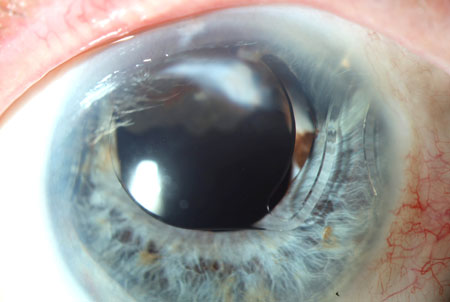BLOG: Secondary IOLs in cataract surgery
In a recent blog entry, we discussed the ramifications of compromised capsules. In this entry we will discuss options that our surgeons resort to when such complications arise unexpectedly during surgery.
Fortunately, when a capsule becomes compromised during surgery, either due to capsular tear or zonular damage, a skilled surgeon has a number of techniques to help minimize surgical aphakia in patients.
Aphakic eyes that have inadequate capsular support can pose great challenges to the cataract surgeon. We will explore a few of the most widely used techniques for placing a secondary IOL to help you better understand what happens during your patient’s complicated cataract surgery.
Anterior chamber IOL
First-generation anterior chamber IOLs were mostly rigid, and their interactions with the angle structures would cause a fairly marked inflammatory reaction. If uveitic glaucoma hyphema (UGH) syndrome followed, the anterior chamber (AC) IOL would need to be explanted.
However, modern anterior chamber IOLs are more flexible and, therefore, much more tolerated and safe. A peripheral iridotomy is often done simultaneously to prevent pupillary block.

A contraindication for placing an AC IOL would be any corneal endothelial disease, peripheral anterior synechiae or compromised iris anatomy. Because of the close proximity of the IOL to the cornea, it is no stretch to see that this scenario can lead to postoperative decompensation of the corneal endothelium.
Additional complications would include bullous keratopathy, UGH syndrome (which may occur early or years after surgery) and cystoid macular edema.
Iris-fixed IOL
The primary advantage of an IOL that is sutured to the iris is that the procedure can be performed through a regular-sized clear corneal incision (CCI), and a standard, foldable, three-piece IOL can be used. This technique needs a normal iris to be able to place the sutures.
Suturing is generally done with a nondissolvable 10-0 Prolene (Ethicon Inc.) material. Even with a nondissolvable material, this may be best in patients who are older, as there is still a high probability of late-suture lysis and subluxation down the road. Further, the suture itself may remain intact, but “cheese wiring” through iris tissue can occur over time.
As expected, the sutures can stretch the iris resulting in correctopia. The intraocular manipulation from the iris suturing can also increase the risk of cystoid macular edema.

Transscleral glue
This technique involves the creation of two scleral flaps, 180 degrees apart, and the use of biologic glue to help secure the IOL in the posterior chamber. This may be the preferred method in patients with poor iris anatomy, younger patients and patients who have UGH, which would be contraindicated for an iris-fixed or anterior chamber IOL.
Yamane technique
Recently popularized, the Yamane technique, is a transconjunctival scleral fixation of an IOL without the need for glue or sutures. Two needles are placed about 2 mm posterior to the limbus, 180 degrees apart, to help thread the leading and trailing haptics of the IOL through the lumen of the needle. Once the haptics are externalized, the end can be cauterizing to form an anchor-like plug to help keep the haptics in the small scleral tunnel.
On early postop exams, you may be able to see the termination bulbs of the haptics about 2 mm from the limbus. As these are essentially a small scleral tunnel, it is important to carefully check them for small wound leaks. Another complication that can arise from this approach is hyphema.
An anterior vitrectomy is a common step involved in all of the secondary IOL placement techniques. Because the vitreous is optically very clear, intravitreal triamcinolone will be used to “cling” to the vitreous, making it more visible. This will help the surgeon better identify that there is no vitreous in the anterior chamber.
As the comanaging doctor, you may very well see residual white precipitate in the vitreous on subsequent postops. Because the additional handling of the vitreous can lead to a tractional retinal detachment in the postop period, it is important to dilate at the postop visits to ensure there is no detachment.
While there are different modalities and surgical approaches to implanting an IOL in the event of capsular compromise, it may ultimately come down to the coexisting ocular pathology of the patient and the technique that the surgeon is most comfortable with performing. A literature review shows that there is not sufficient evidence to indicate one technique is superior or safer than another.
One of the surgeons that we work with, Dr. Jason Leng, has modified his technique for placement of transconjunctival sutureless IOL fixation. We thought you may find his video helpful in understanding the technique.
Reference:
Wagoner MD, et al. Ophthalmology. 2003;110:840-859.
